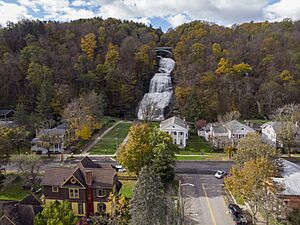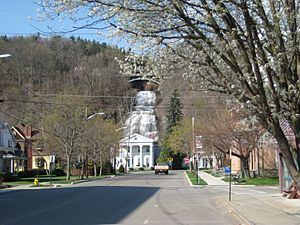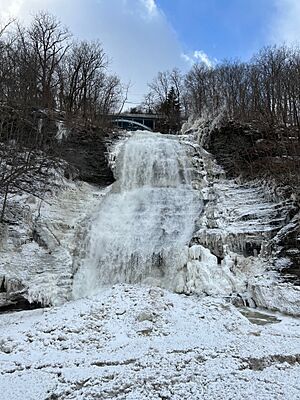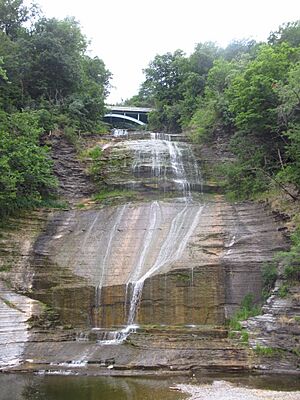Montour Falls, New York facts for kids
Quick facts for kids
Montour Falls, New York
|
|
|---|---|
|
Village
|
|
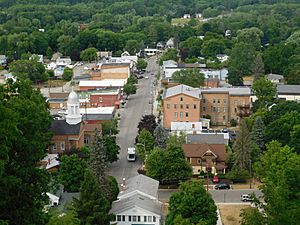
Downtown Montour Falls as seen from Mill Street above Shequaga Falls.
|
|
| Country | United States |
| State | New York |
| County | Schuyler |
| Area | |
| • Total | 3.03 sq mi (7.85 km2) |
| • Land | 3.01 sq mi (7.79 km2) |
| • Water | 0.02 sq mi (0.06 km2) |
| Elevation | 449 ft (137 m) |
| Population
(2020)
|
|
| • Total | 1,635 |
| • Density | 543.55/sq mi (209.84/km2) |
| Time zone | UTC-5 (Eastern (EST)) |
| • Summer (DST) | UTC-4 (EDT) |
| ZIP code |
14865
|
| Area code(s) | 607 |
| FIPS code | 36-48197 |
| GNIS feature ID | 0974235 |
Montour Falls is a small village in Schuyler County, New York, United States. In 2020, about 1,635 people lived there. The village gets its name from a beautiful waterfall at the end of West Main Street. The name "Montour" comes from Queen Catharine Montour. She was an important Native American woman from the Seneca tribe who lived in the area in the 1700s.
Most of Montour Falls is in the Town of Montour. A small part is in the Town of Dix. The village is about 20 miles north of Elmira, New York. It is also about three miles south of Watkins Glen, New York. The New York State Academy of Fire Science is located in the village.
Contents
History of Montour Falls
The village of Montour Falls is built where an old Seneca Indian village once stood. This village was called Queanettquaga. It was also known as Catherine's Town. This name came from Queen Catharine Montour, a respected Seneca leader. Her father was a Mohawk Chief, and her mother was the daughter of an Oneida Chief. Queen Catharine Montour married a Seneca Indian Chief named Thomas Htitson. Her Seneca tribe was part of the Iroquois Confederacy.
During the American War of Independence, some Iroquois tribes helped Great Britain. Because of this, American forces took action against them. In 1779, the Battle of Newtown, New York happened nearby. After this battle, the Sullivan-Clinton Expedition marched through the area. They destroyed Queanettquaga and many other Native American villages. They burned homes, cut down orchards, and killed livestock. The people of Catherine's Town had to move far away, even to Canada. Queen Catharine Montour was born around 1710 and died in 1804. There is a grave mound in her memory in Montour Falls.
European Americans began settling in the area around 1788. By 1805, the place was called Mill's Landing. This name honored George Mills, a local resident. He became the postmaster in 1802, which is often seen as the start of the community. In 1802, only about twenty people lived there, and there were no stores.
The Chemung Canal and Village Names
From 1827 to 1833, the Chemung Canal was built through Mill's Landing. This canal connected the Chemung River to Seneca Lake. Mill's Landing became important for trade because of its location. Another canal at the north end of Seneca Lake connected to the Erie Canal. This allowed goods to travel to the Great Lakes and to New York City.
The village officially became a town on May 13, 1836. It was given a new name: Havana, New York. In 1854, the village of Havana became the first main town, or county seat, of the new Schuyler County. However, by 1861, the county seat moved to Watkins Glen.
The village changed its name again to Montour Falls on March 20, 1895. The nearby Town of Montour is also named after Queen Catharine Montour.
From 1850 to 1888, several companies in Havana made stoneware pottery. These included Savage, Parsons & Co., Brewer & Halm, and others.
Important People and Businesses
Charles Cook was a businessman and politician. He helped create Schuyler County in 1854. He also started the Cook Academy in 1858. Today, this building is home to the New York State Academy of Fire Science. Charles Cook was also the president of the Chemung Canal Trust Bank. This bank has been open since 1835. Charles Cook never married.
In 1872, two engineers from Havana started a company called Shepard Niles. They made equipment for moving heavy materials. In 1902, they built their first heavy-duty crane. Their cranes and hoists were known for lasting a long time. They helped America become a strong industrial nation. The company is still in business today, though its main operations are no longer in Montour Falls.
In 1934, the National Bank of Montour Falls was listed in the Federal Reserve Bank system. The bank even issued a US $10.00 bill that year.
Montour Falls is famous for its beautiful 165-foot waterfall. It is located on the west side of the village. At the bottom of the falls, a sign says "She-qua-ga." This is how the Seneca name for the falls sounds. A bridge above the waterfall spells the name "Che-qua-ga." Many old names have different spellings because people tried to write them down from different languages. This waterfall is also simply called "Montour Falls."
Several historic places in Montour Falls are listed on the National Register of Historic Places. These include the Brick Tavern Stand, the Montour Falls Historic District, and the Montour Falls Union Grammar School.
Geography of Montour Falls
Montour Falls is located at 42°20′57″N 76°50′47″W / 42.34917°N 76.84639°W.
The village covers about 3.0 square miles (7.8 square kilometers). Most of this area is land, with a small amount of water. Catharine Creek flows north through the Catharine Creek Valley. It eventually reaches Seneca Lake.
New York State Route 14 and New York State Route 224 meet in Montour Falls.
Population and People
| Historical population | |||
|---|---|---|---|
| Census | Pop. | %± | |
| 1870 | 1,273 | — | |
| 1880 | 1,274 | 0.1% | |
| 1890 | 1,751 | 37.4% | |
| 1900 | 1,193 | −31.9% | |
| 1910 | 1,208 | 1.3% | |
| 1920 | 1,560 | 29.1% | |
| 1930 | 1,489 | −4.6% | |
| 1940 | 1,345 | −9.7% | |
| 1950 | 1,457 | 8.3% | |
| 1960 | 1,533 | 5.2% | |
| 1970 | 1,534 | 0.1% | |
| 1980 | 1,791 | 16.8% | |
| 1990 | 1,845 | 3.0% | |
| 2000 | 1,797 | −2.6% | |
| 2010 | 1,711 | −4.8% | |
| 2020 | 1,635 | −4.4% | |
| U.S. Decennial Census | |||
In 2000, there were 1,797 people living in Montour Falls. There were 701 households and 419 families. The population density was about 598 people per square mile. Most of the people living in the village (97.61%) were White.
About 26.1% of households had children under 18. About 42.2% were married couples. The average household had 2.22 people. The average family had 2.79 people.
The population's age was spread out. About 19.1% were under 18. About 27.7% were 65 or older. The average age was 44 years old.
The median income for a household was $29,018. The median income for a family was $36,307. About 15.3% of the population lived below the poverty line. This included 24.0% of those under 18.
Notable People from Montour Falls
- William Terry Jackson: He was a US Congressman from 1849 to 1851. He died in Havana, New York, in 1882.
- David Bennett Hill: Born in Havana, New York, in 1843. He was the 29th Governor of New York from 1885 to 1891.
- Charles Cook: A State Senator in 1862-1863. He helped create Schuyler County in 1854. He also founded Cook Academy in 1858.
- Jane Arminda Delano: Born in Havana, New York, in 1862. She founded the American Red Cross Nursing Service. She is buried at Arlington National Cemetery.
See also
 In Spanish: Montour Falls para niños
In Spanish: Montour Falls para niños



